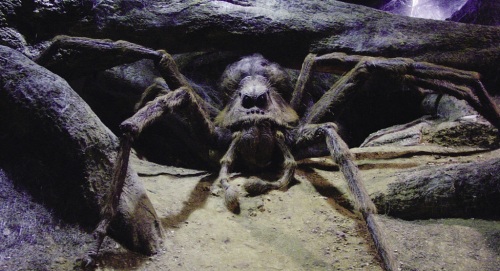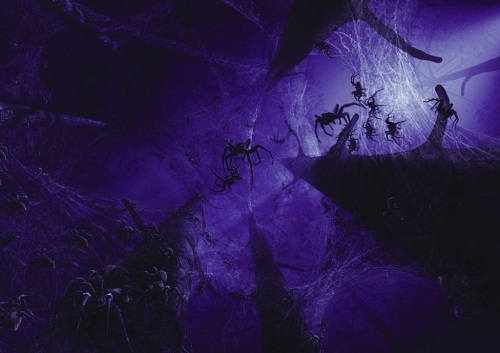From the middle of the misty domed web, a spider the size of a small elephant emerged, very slowly. There was grey in the black of his body and legs, and each of the eyes on his ugly, pincered head was milky white. He was blind.
‘What is it?’ he said, clicking his pincers rapidly.
-J.K. Rowling, Harry Potter and the Chamber of Secrets

Concept artist Adam Brockbank was assigned the task to design Aragog for the film adaptation of Chamber of Secrets. After various iterations, which were based on different species of spiders, the filmmakers ultimately settled upon what was fundamentally a magnified Wolf Spider. Sculptural details were also added to enhance Aragog’s old age.
“I come from a distant land. A traveller gave me to Hagrid when I was an egg. Hagrid was only a boy, but he cared for me, hidden in a cupboard in the castle, feeding me on scraps from the table. Hagrid is my good friend, and a good man. When I was discovered, and blamed for the death of a girl, he protected me. I have lived here in the Forest ever since, where Hagrid still visits me. He even found me a wife, Mosag, and you see how our family has grown, all through Hagrid’s goodness…”
Aragog was originally going to be portrayed by a digital model, but it was ultimately decided to build a full-size puppet, with digital effects mostly delegated to create Aragog’s children. This choice not only saved budget, but provided the young actors an actual full-size Monster to react against. Nick Dudman, head of the creature effects team, related: “I’m a great believer in giving actors — especially young actors — everything you possibly can to help them react properly. This spider actually crawled out of a hole in front of the kids and talked to them — and they reacted accordingly.”

Constructing Aragog and operating him on set proved to be the most challenging task Dudman and crew were assigned for the production — the character alone required a crew of 97 people. The spider had a 10-foot body and a 18-foot leg span and was sculpted in full-size by Gary Pollard. The body was sculpted separately from the legs.
The actual animatronic featured a steel armature, which was covered with foam latex skin. Each one of the spider’s hairs was manually inserted; the finer hairs were broom hairs, whereas the larger ones were feathers with a coat of synthetic hair and Lurex. The body was constructed with a fiberglass supporting structure that covered the steel armature, and was in turn covered by the skin. Animatronic supervisor Chris Barton, aided by animatronic engineers Simon Williams and Steve Wright, devised the mechanisms animating the giant spider, whereas the electronics were assigned to Tamzine Hanks.
Aragog’s face could perform a range of detailed movements to suggest talking motion. “Its eyes, its front hairy teeth, and other bits in his face moved,” Dudman related, “they were all hooked up through a Gilderfluke computer-controlled system.” The animatronic was programmed to deliver recorded dialogue (voice actor Julian Glover’s lines) on set. “Everyone on set could hear the spider through a loudspeaker,” Dudman said. “We could literally pause the dialogue to allow Harry to say his lines, then cut in with the spider’s dialogue.”
Aragog’s legs were mechanized with aquatronics — hydraulic systems that function with water. Dudman related: “it created the gentle, quiet movement that spider legs have. It was quite creepy.” Aragog’s four front legs were puppeteered through mechanical articulated rods called waldos — which reproduced movements made by controllers — whereas the rear legs (whose tips would be seen by the camera) were manually puppeteered by crewmembers in the hole.
To animate the spider, it was pushed out to give the impression of it crawling towards Harry and Ron. “Basically, the guys moved the spider around physically by pulling its legs and pushing its body along, and whatever they did was mirrored on the set,” Dudman explained. “The front legs had to give the impression they were pulling the body out even though it was really getting pushed out. We put a little radar unit at the tip of each leg so the performers would always know when the leg made contact with the ground. Holding that position made the spider look like it was taking weight on that leg. If a leg was coming within six inches of the ground, a green light came on and when it touched the ground a red light came on. The performers also had monitors at disposal, so that they could see where the legs were going on the set.”
Once the front legs rose from the hole and touched the ground, the crew had to lift up the body. The animatronic was mounted on a pole-armed teeterboard, which had a counterweight on the other end and was buried in a hole in the set. Dudman said: “the spider was on one end and on the other end was a quarter-ton of weight, so it was steered out of the hole a bit like a camera crane.”
‘We’ll just go, then,’ Harry called desperately to Aragog, hearing leaves rustling behind him.
‘Go?’ said Aragog slowly. ‘I think not …’
‘But – but –’
‘My sons and daughters do not harm Hagrid, on my command.
But I cannot deny them fresh meat, when it wanders so willingly into our midst. Goodbye, friend of Hagrid.’
The design of Aragog’s children was simplistically reverse-engineered starting from the parent’s appearance. Dudman’s team devised 12 full-size animatronics ranging from three-foot to five-foot spiders. One of the puppets was limitedly articulated and was used for an insert shot of a spider attacking Ron from outside the car. However, the majority of them were only built to be used as on-set reference for the CGI team. “By putting any of these 12 spiders into a sequence, they could see what the spiders would look like,” Dudman said, “and what space they would take up. But the action of these spiders was too frenetic for animatronics.”
The digital spider sequences were provided by Mill Film, whose team started by scanning one of Dudman’s spiders. The scan data after various processes was imported to Maya, where Burke and Ivor Middleton began experimenting with animation studies. Burke explained: “we had two different issues: little spiders and large spiders. With the little ones, we had to deal with adapting our flocking system to give us a new library of animation functions so we could tackle a large number of shots with flexibility and have them move on the surfaces of the set. For the large ones, we had to develop the aggressive nature of the spiders.”
Middleton led a team of 17 animators in creating animation libraries of varied walking cycles — slow walking motions, creeping motions, rock climbing, running. TD supervisor Laurent Kermel developed a ‘semi-procedural’ Maya plug-in to perform crowd animation of the smaller spiders. The procedural system generated motion for a mass of particles which was then replaced with the spider models. Output from this simulation drove the animation of the spiders’ legs. He explained: Qfirst, we’d set parameters in the system that controlled speed, force, how far they could see and so forth; and then we’d set parameters that controlled the way they reacted in particular situations — for example, when they bumped into obstacles or got scared. We’d test this on a group of 10 to 20 spiders, and when we had their ‘DNA’ the way we liked it, we’d apply it either to create the entire mass of 1000 spiders or to a percentage. We could paint the areas where we wanted them to go or not go, place obstacles they would avoid or that might scare them to run away, or stop the simulation to a specific frame number to hand-animate a group of spiders, and then start it up again. Or an animator could pick one spider out of the group and animate it by hand. There were tons of tools.”
This system also created a starting point for the larger spiders, which would understandably need to be animated manually. Middleton explained: “for spiders closer in, an animator would start with the animation generated by the program and develop it further. The flocking software gave us spiders moving in a coherent fashion and helped us block out scenes — but we still had to put a lot of work into getting the size and weight and look of the motion right for the larger ones.
Dear Harry, Ron, and Hermione!
Aragog died last night. Harry and Ron, you met him and you know how special he was. Hermione, I know you’d have liked him. It would mean a lot to me if you’d nip down for the burial later this evening. I’m planning on doing it round dusk, that was his favourite time of day. I know you’re not supposed to be out that late, but you can use the cloak. Wouldn’t ask, but I can’t face it alone.Hagrid
In Harry Potter and the Half-Blood Prince, the audience witnesses the funeral of the giant spider. The dead Aragog was portrayed by a full-size model devised by Shaune Harrison and crew. Its sculpture was based on the Chamber of Secrets Aragog moulds, but manually resculpted to show its age and decay. The model was moulded in urethane to reproduce the translucent quality of a real dead spider, and its hairs were built with the same materials as the other puppet. Aragog was a beloved character of the creature effects team — so much that the crew actually wore black armbands during filming of the spider’s funeral scene.
Aragog’s legacy lived on, with his offspring making one final appearance in Harry Potter and the Deathly Hallows during the battle for Hogwarts — as digital creatures. ” Framestore did the giant spiders,” said visual effects supervisor Tim Burke. “That has a sweet backstory. Andy Kind, the supervisor who did the spiders, was the one at Mill Film who had worked with me on the spiders on the second film nine years back. Mill Film closed down, so those spiders no longer existed. He rebuilt them by referencing footage from that film.”
Farewell, Aragog, king of arachnids, whose long and faithful friendship those who knew you won’t forget! Though your body will decay, your spirit lingers on in the quiet, web-spun places of your forest home. May your many-eyed descendants ever flourish and your human friends find solace for the loss they have sustained.
For more pictures of Aragog and his spawn, visit the Monster Galleries:












One thought on “Aragog”